What Goes Into Survival: A Report from the Washington Rally
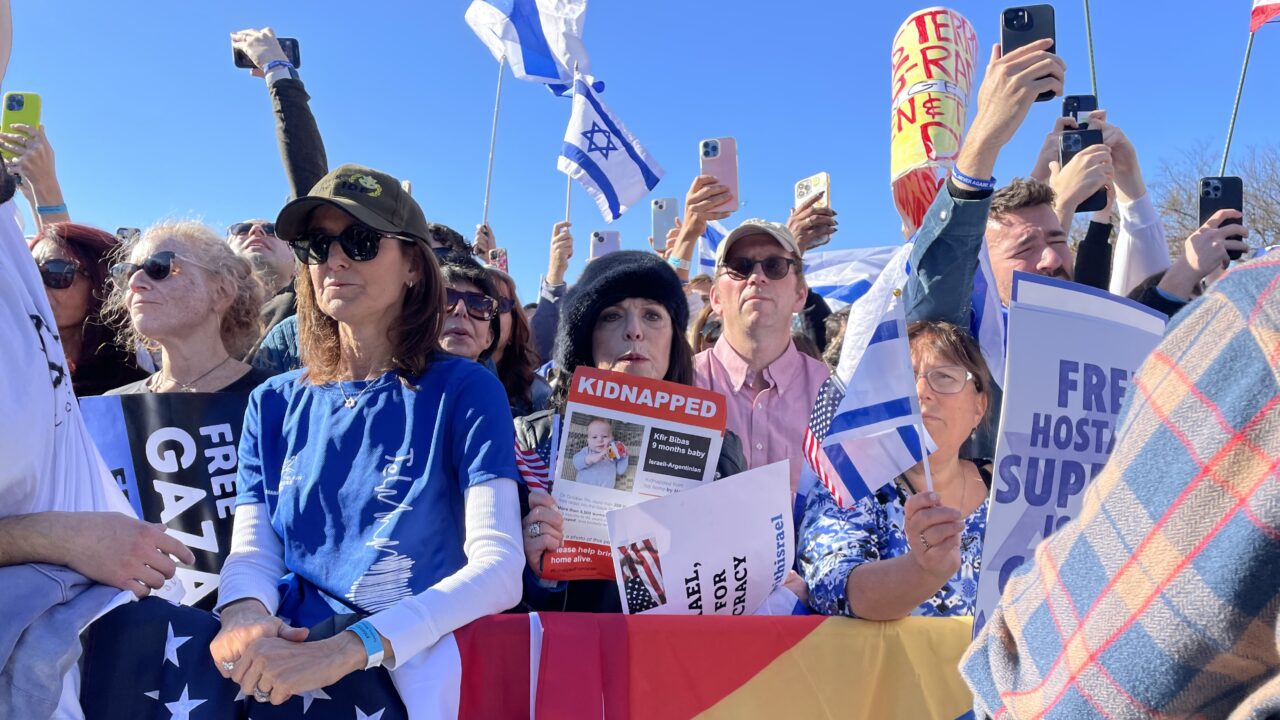
“When we say never again, we mean it,” said Steven Rosen. He had arrived, via overnight bus, in Washington DC, and was holding a small, stark poster: “Free Gaza From Hamas.” “Two Jews, three opinions,” he said. Here, the math was simpler. “A million opinions, but one belief—this needs to end.”
Scenes from Tuesday’s enormous “March for Israel” rally were like that. Rosen, wearing jeans, Sauconys, and a calmly fed up expression, didn’t mean that the war must end. He meant Hamas. He was surrounded by tens of thousands, in the middle of the National Mall, who agreed wholeheartedly.
A strange feeling—of both threat and protection—prevailed early. A fleet of security guards arrived in the pre-dawn, at 5:30am. By 8:30am, a pair of thirteen-ton dump trucks formed a thirty-five-foot-long barricade across 4th Street, near the stage.
Soon enough, the mood began to lighten. People dressed comfortably, in jeans and sneakers. Israeli flags were everywhere: they sprouted from backpacks, billowed off of backs and shoulders. A sound system blasted Israeli techno music.
Further up Madison Drive, David Gabriel, twenty-two, was helping Peter Greenberg with tefillin. Gabriel had driven from Brooklyn early that morning but looked suspiciously bright-eyed. “Moshiach now!” he yelled. Further up, along the Mall, two young women gathered beside an event poster that had been defaced. “Does anyone have a Sharpie?” one yelled. No one had a Sharpie. A nurse from Philadelphia stopped and produced, from her pursue, a tube of mascara and, to everyone’s delight, performed some deft relettering: “genocide” became “generosity,” and “free Palestine” became “free our hostages.” Voila: poster rectified.
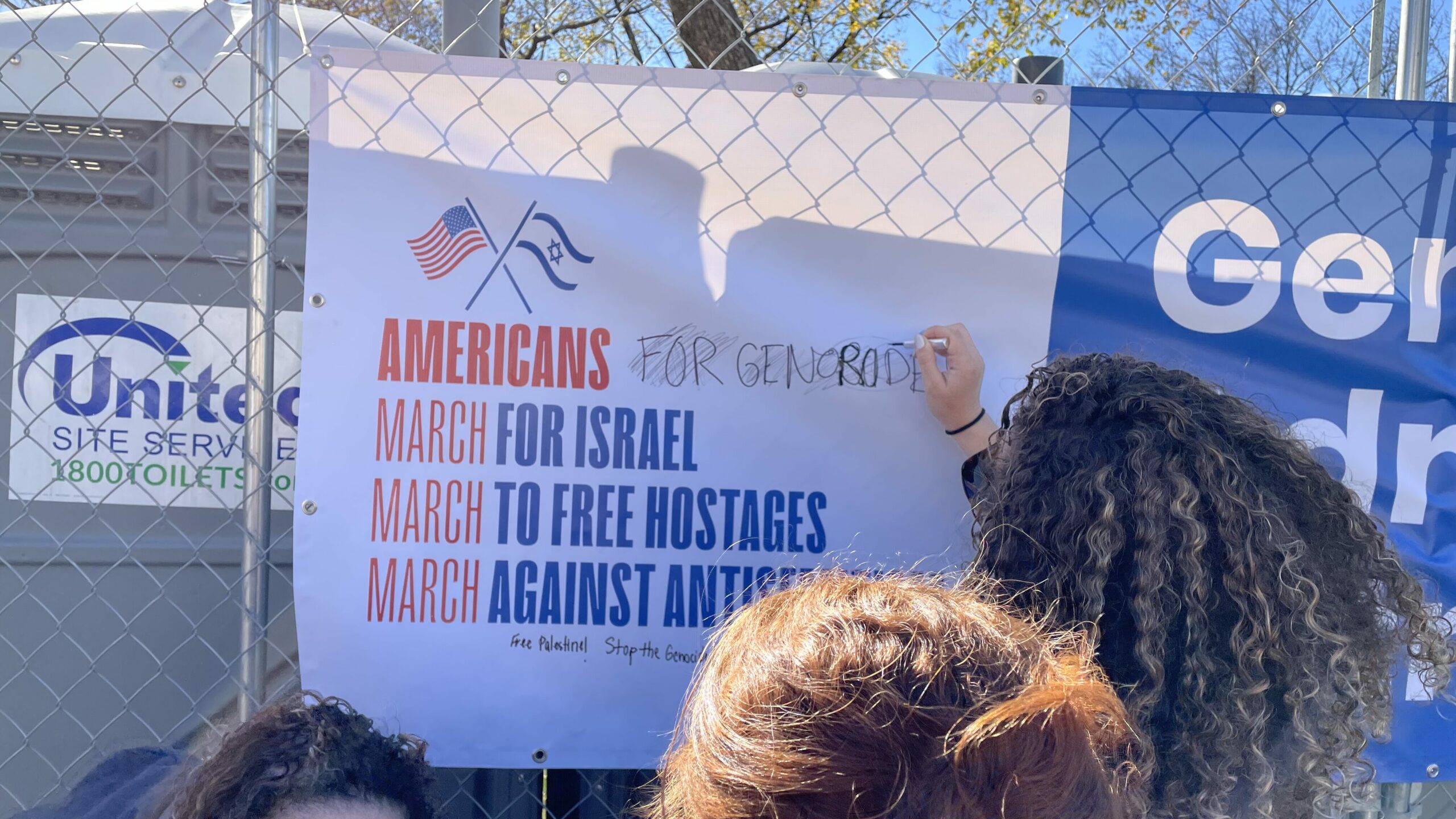
The mood was light, with an undertow. Teenagers joked. The looks on children’s faces said that they had never seen so many people. T-shirts bore the names and faces of the hostages.
The shirts were a reminder—not that one was needed. It had been a terrible month. Of that, everyone who trekked to Washington, DC could agree. Not just terrible, of course, but keenly, unspeakably so. The slaughter of 1,200 Israelis—children, parents, soldiers, siblings, infants—in a gruesome, ecstatic frenzy; an event with no meaning outside its horror. Hence the mixed mood of yesterday’s rally, a show of pride and defiance, as well as communal mourning, the world’s largest shiva.
It wasn’t only Hamas’s massacre, but the sequelae, the shocking responses.
The anti-Israel rallies. The withdrawal of the world’s sympathy. The notorious Harvard letter: thirty-one student groups endorsing Hamas’s attack. “It Shouldn’t Be Hard to Condemn Terrorists,” ran one headline. Apparently, it was.
Hundreds of thousands marched in London. Israelis buried their dead when they weren’t ducking into bomb shelters. That Israelis might find this intolerable didn’t seem to register with anyone. “I’m marching for humanity,” one protester explained. Whose? Across the US, students rallied against Israel. The ADL reported a fourfold increase in antisemitism.
It was once said that the Nazis made murder feasible. Now, it seemed, Jew-hatred was feasible. Something had changed, a slow, insidious erosion of mores, a loosening of taboos. “I never imagined antisemitism would get this bad,” Deborah Lipstadt, who spoke at the rally, said this week. “How has it come to this?” the writer Susie Linfield asked in 2019. “How has ‘Zionist’ … become the dirtiest word to the international Left—akin, say to racist, pedophile or rapist?”
After October 7, scattered contempt seemed to morph into a global derangement. In Sydney, Australia, chants of “gas the Jews”; in France, blue stars stenciled on Jewish businesses. “We are also freedom fighters,” an American chapter of Black Lives Matter announced. The words zipped around the world via social media.
Not all the news was disheartening. Against the tide of backwardness and illogic, a sort of Jewish Sanity Coalition emerged, mainly online. “This is our country, and we will keep it safe from the thugs,” Ruth Wisse wrote. The journalist Joe Klein found himself “overwhelmed by anger and fear and frustration with those who don’t understand that Israel is an existential necessity for the Jewish people.” Eric Spiegelman, a Democratic Socialist, noted the party’s new priorities: “affordable housing, raising the minimum wage, and the wholesale murder of Jews.” There was Fania Oz-Salzberger, clear-eyed, tough-minded. “No, Israel doesn’t intend to lay down and die in order to #FreePalestine,” she wrote. “Any further questions?”
During this tense, unbalanced moment, the March for Israel was conceived. In the days ahead of it, one sensed something historic. “See you in Washington,” the president of Yeshiva University, in New York City, announced on X (née Twitter). No one had to skip class—they were cancelled. “There are times when Hashem invites us to participate in the unfolding of Jewish history,” he later said. “This is one of those times.”
Indeed, people came, schlepping by train, chartered bus, overnight flight. Students raised money from relatives. Federations funded last-minute airfare. It was a rally for people who don’t attend rallies.
“I haven’t been to an Israel rally since the Apollo-Soyuz rocket launch,” said Rosen, still calmly seated. As he spoke, a man walked past with a two-sided sign. One side read, “This is not complicated,” but the other suggested a complication: “All war is bad; some war is just.” Eight simple words, but it captured a moral dilemma. “What goes into survival isn’t always pretty,” Philip Roth once wrote. George Orwell, impeccably clear-eyed, said much the same. “We have become too civilized to grasp the obvious,” he wrote. “For the truth is very simple. To survive you often have to fight, and to fight you have to dirty yourself. War is evil, and it is often the lesser evil.” Such was the consensus at the National Mall: right now, war is the lesser evil, a rational, justified response. Among the chants were “No cease-fire!”
It was, as mass rallies go, well-behaved, spirited but civilized. Ten days earlier, thousands of pro-Palestinian marchers flooded Freedom Plaza, leaving blood-red handprints on the white stone pillars outside the White House. At a New York rally, things turned ugly: a widely shared video showed a man in black, masked and hooded, yelling “Cry, bitch, cry” and “You Zionist pig” at an Israeli woman. A mile away, a violent vanguard bashed Grand Central Station’s doors, though local news called them “mostly peaceful” (“If that’s peace, what does violence look like?” the writer Judith Shulevitz wondered.)
All that felt far away—yet unsettlingly close—on Tuesday. The march had been planned so quickly, it was almost spontaneous. The day’s speakers weren’t announced until days before, but then the speakers weren’t the main attraction. The point of coming had been… to come. To be together. It had the feel of a family gathering.
The cries to resist fear underscored just how fearful everyone was. “You are not frightened, you are not silenced,” Natan Sharansky told the crowd, speaking especially to students near the stage. His words were echoed by Deborah Lipstadt: “Do not cower! Allow no one to make you afraid.”
One hundred feet from the stage, taped to metal barricades, were an endless row of hostage fliers. “Together we grieve and together we shall overcome,” the president of Israel, Isaac Herzog, was saying. He captured the mood of certain moments: resolved but heavy-hearted.
Through the day, one name was conspicuously absent. What was Netanyahu’s future? At the moment, it looked grim, not that anyone seemed to worry about it. “We all hope he’s gone,” said Elinor Burkett, seventy-seven, whose shirt bore a portrait of Golda Meir, whom she much preferred (Burkett is Meir’s biographer).
A similar disgust was felt more generally. After October 7, some Jewish groups closed ranks—for Palestine. So did non-Jewish activists. Many liberal Jews discovered—painfully—that their friends despised Israel.
“I feel like my community has disintegrated,” said Gabrielle Elkaim, a government employee, whose two best friends—well, former friends—are anti-Israel. “I live in a woke-left world,” she said, “but there’s a silver lining: I’ve gotten to see who people really are.” She paused. “I’m just blown away by the level of groupthink.” Could those friendships be repaired in time? “I doubt it,” she said immediately. “I highly doubt it.”
To distract herself, and meet new people, she’s begun hosting Shabbat dinners. It was nice to feel something besides anguish, she said.
The need to feel something else, if only briefly, was widely shared. It had been five weeks—to the day—since the atrocities, and everyone had felt too much. Too much horror, too much grief, too much worry. Watching the news, avoiding the news, feeling engulfed—it was the common experience. Some were discussing how to modulate one’s news intake. “It’s a little skewed, but okay,” a woman said of CNN’s coverage.
As for survival strategies, I thought of the obvious one. “The world’s end can’t put an end to Jewish wit,” Saul Bellow once wrote. Indeed, it lives. Calls for cease-fire were mocked online. (“There was a cease-fire on October 6. Did something happen?”) So was the self-importance of petition signers. Howard Jacobson jeered a “serial signer … who would boycott a bagel if it had been baked in Israel.”
At the rally, much concern centered on college students. On campuses, the only safe spaces were libraries—until they weren’t. At NYU, thirty masked students swarmed the library, chanting “Free Palestine!” while security watched. A few blocks south, at Cooper Union, Jewish students were barricaded inside the library while a braying mob pounded the doors.
At Tulane University, a melee erupted; a Jewish student left with a broken nose. “It’s been terrifying,” says Bali Levine, a junior, who spoke at the DC rally, and had helped rescue the assaulted student. “I’ve never before been afraid to express my Judaism. And I’m still not. But I’m one of the few.” Lately, she’s been doing the job of a chaplain: comforting pro-Israel friends and strangers. Many feel threatened, as does she, thanks to a deluge of anti-Israel messages on her Instagram.
There were so much abuse—“My comments section was like a war zone”—that she drafted a new post: for every new attack, she would donate $3 to Israel. “I thought I would go broke!” she laughed. Before long, she was Venmo-ing $652 to support Israel.
Campus anti-Zionism wasn’t unforeseen; students had been groomed. From a cultural studies perspective, history is simple: there are white oppressors and dark-skinned victims. To favor oppression is “to be on the wrong side of history.” Never mind that history is complex; that “white” is not a moral category. The people capable of nuanced thought—call them “the adults”—had left the classroom. Student activists were emboldened to act viciously and unforgivingly.
After October 7, campus radicals were ensnared in their own logic. If Israel was a racist state, a criminal state, then “resistance is justified,” and the slaughter of Israelis was allowable. Regrettable, perhaps. But allowable. Attacking Israel offered a sadistic thrill; the pleasure of contempt; an easy sense of virtue. Never mind what John Erskine called “the moral obligation to be intelligent.”
Then again, being intelligent about Israel was always hard. The Middle East is “the graveyard … of clear-headed moral and legal discussion,” the scholar Fred Halliday once wrote. Susie Linfield concurred: “Many otherwise intelligent people abandon common sense and their ethical compass when it comes to Middle East politics.” At times I wondered darkly—it was a time for dark wonderings—if people sincerely cared about Palestinians.
“Do you know why we Palestinians are famous? Because you are our enemy,” the poet Mahmoud Darwish once said. If Palestine fought with Pakistan, would it matter to people? “The international interest in the Palestinian question is only a reflection of the interest in the Jewish question,” he said, noting: “We are lucky that Israel is our enemy.”
Practically everyone in DC had been following the large pro-Palestine rallies all over the world. A week earlier, I’d had the surreal experience of sitting in the Dorot Jewish Division of the New York Public Library and hearing pro-Palestine chants outside. I had been glued to YouTube for weeks, but now an actual, three-dimensional rally sparked my curiosity. Up close, the face of anti-Zionism (let’s be generous) looked surprisingly benign: more clueless and ignorant than malevolent. Teenagers. Scruffy men in shirts. Lots of young women. They may have been tipsy with virtue, but there was nothing grotesque about them. They were normal-looking people calling for the destruction of a country most of them had never seen and knew nothing about. To be honest, I didn’t know quite what to feel: sadness? Contempt? Amazement? Did they understand what they were chanting?
Across 42nd street, a tiny counter-protest, no more than a minyan, was being held, with an Israeli flag draped over a police barricade. “Jew-haters,” a man said with disgust, eyeing the protesters. He wasn’t in a mood for words, and spoke tersely. “After we win this war”—he gestured across the street—“they will all disappear. But we won’t forget that they’re here, among us. We won’t forget.”
A week later, in DC, I had a disheartening thought. What can a rally, even a large, historic rally, accomplish? It can’t sway people, change policy, free hostages. “It doesn’t feel like we’re doing anything—but we have to do it anyway,” said Lonnie Pelcovitz, an attorney who came with her husband. “It’s been amazing to see such solidarity,” she added. “That’s what I wanted to see. That’s why this is important—to strengthen our resolve.”
Around 3:00 p.m., a surprisingly clean Mall began to empty. Marchers fanned out across Madison and Pennsylvania Avenue. “This was really heartening,” said Hannah Kroll, a DC resident, as a tired-but-cheerful crowd passed. “It’s been a lonely, difficult month; you don’t know who to trust. But even though”—at that point, she recognized a friend and broke off. Three minutes later, she was back. “Even though it’s 100,000 people, it’s all one community. That’s the crazy thing.”
Suggested Reading
More Important Things
Francesca Segal's prize-winning The Innocents: A generous, garrulous, and utterly genuine group portrait of Anglo-Jewry.
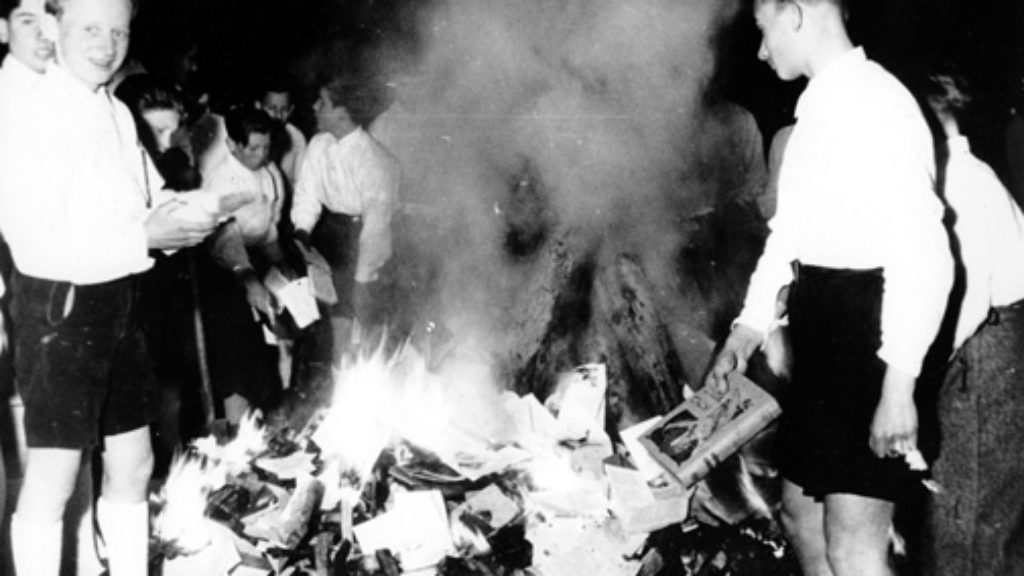
Why the Germans?
Was Nazi hatred of the Jews driven by envy of their economic and social success or rather by a fear of a perceived threat to German culture and identity?
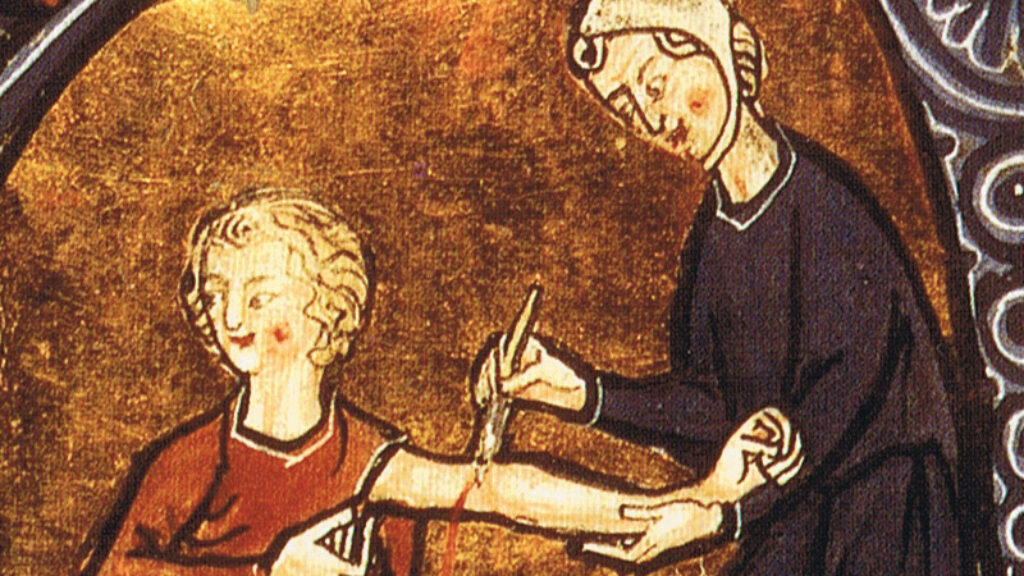
No Balm
A new book on talmudic medicine illustrates the ills of modern academia, argues Shai Secunda.

Ritchie’s Boys and the Men from Zion
Our appreciation for stories of Jewish bravery during World War II sometimes obscures the fact that as a group Jews were powerless, reduced to begging others for a chance to bear arms.
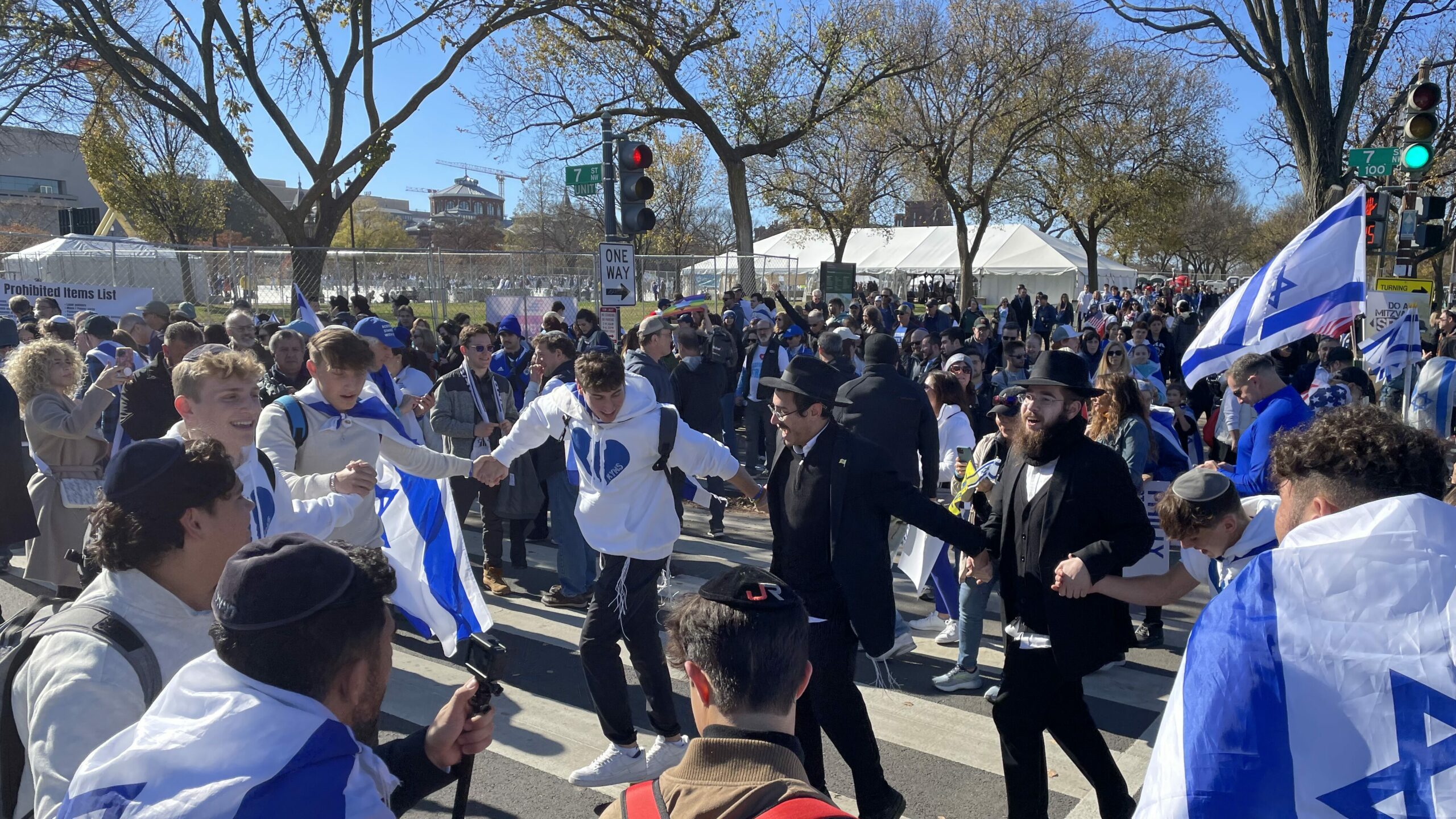
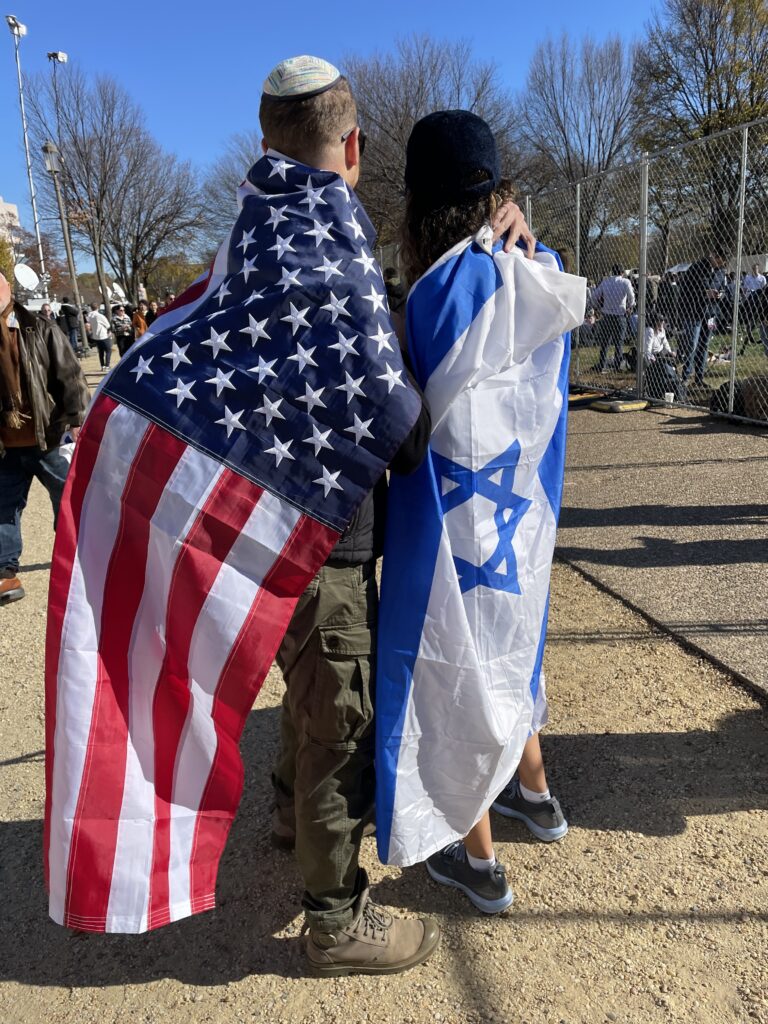
Comments
You must log in to comment Log In